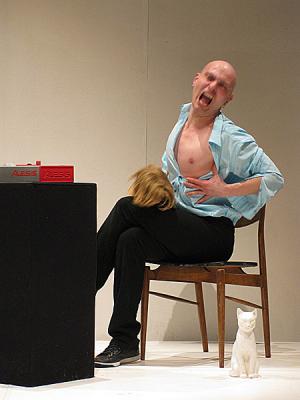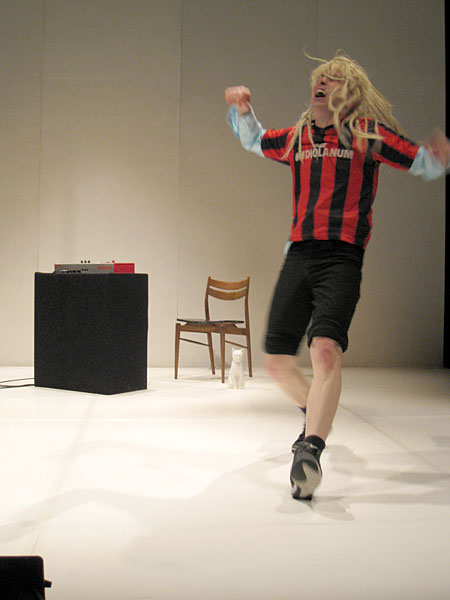It should be pointed out from the very beginning that Som Faves by Ivo Dimchev is one of those artistic products which can be subject to numerous interpretations, as its author provided it with a very generous substance in this respect. Before starting writing this article I hesitated between at least three perspectives on the performance and I must admit, it doesn't happen to me very often, either because of a crisis of the critical material or of a too big... "transparency" of the analysed creations.
My indecision in choosing a certain perspective was generated by the way in which the intention of the artist had been materialized: what is staged as extremely personal, autobiographical or self-defining finally proves an universal statement which is targeted at the condition of art and, implicitly, of the artist, at the fragile border between the one who is watching and the one who is being watched, at the problematics of death, strongly related to art, at the sometimes undistinguishable relation between the one who consumes and the one who is consumed... And I can go on with more examples...
In fact, to my understanding, Som Faves proves a discourse about authenticity, in its broadest and all embracing meaning. On the other hand, the artist aims at re-orientating the regard of the audience to a new ontological condition of art and, more extensively, to a new axiology, to a new way of assuming the values.
I have chosen the perspective presented in this article thanks to some words that Ivo Dimchev utters to the end of the performance: "One of the main signs of getting older is the need of balance...". He initially refers to the balance between form and content when we perceive a cultural act, but his discourse helps us easily extrapolate this fact over other plans, whether this plans are related to general values or to our personal life.
The audience is sure to admire the extraordinary exposure of Ivo Dimchev's multiple talents, from his vocal qualities to the acting abilities. But this qualities, taken as a whole, function as a trap attentively elaborated by the performer: they are exposed with the precise purpose to shed light on the fact that the nowadays spectator is constantly searching for a balance between form and content.
The spectator's focus on the "seducing form" is counterpointed and balanced only by the theoretical effort to find a meaning beyond the appearance, to grasp the essence veiled by what is seen. The contemporary spectator and many nowadays artists are, therefore, constantly looking for a balance between what is shown to us and what is hidden as meaning by appearance. After surpassing certain stages that lead to the above mentioned conclusion, Ivo Dimchev's message is obvious: the drama shows in the picture the very moment that we separate form and content in our minds. This separation which, for Ivo Dimchev is synonym to a mistake, can be regarded in the light of what Antonio Damasio calls "Descates' error": the separation of the soul (the thinking substance) from the body (the material substance). This separation, imposed during the period of philosophical rationalism by Rene Descartes (and methodically corrected by Benedict Spinoza) generated an entire history of dichotomies.
According to the model (that was already announced somehow by Plato's theory of Ideas) of splitting the body from the soul, there has been reached, in art, certain theories that judge the artistic product by a content that is necessarily hidden by appearances. It is exactly this fact that Ivo Dimchev tries to present as an error. Once we get to this point, if we watch the performance retrospectively, we can correct the way we have perceived every step of the way and we can understand that the logical structure of what has been shown to us is a meta-discourse which universalizes what has been brought on stage.
Let's give only one example: the painting hanging on the perpendicular white wall of the scenery. We find out from the artist that it is a 5 euros painting that he has bought from the open market in Amsterdam. This very moment, the regard of the audience is directed in a very specific way at the object on the wall: it is not an expensive original bought at some prestigious auction... So... Once the regard of the audience is thus orientated, there comes the cry of the artist: "Respect art!" It won't take long until we discover that: "If you don't respect art, it's nothing wrong with you!" Therefore, to what conclusion are we led by this dialectics or our relation with art?
The intention can be the dislocation of our traditional way of regarding art as we have been accustomed to, through the cultural patterns that generated an entire typology of the perceivers of art and that fulfilled a real marriage between the rules of art and moral principles.
By confronting the audience to concepts turned into moral and aesthetical stereotypes, by recontextualizing what we call art, Ivo Dimchev tries to shift the perception of the audience to a re-thinking of the way art is understood and perceived.
This stage of the performance is only one of the elements that design the strategy of the artist to challenge the audience so that they could think the artistic act beyond traditional dichotomies.
If there is something radically authentic in this performance, it is exactly the way in which Ivo Dimchev, under the umbrella of a complete show (as far as the means are concerned), elaborates a methodology meant to change the way in which art is perceived. In fact, it is a complex pedagogical experiment, through which we are led to reconsidering what we, as spectators, assume to be valid. If the need for balance is a sign of getting old, it means that the creators, as well as the ones who are watching fully contribute to art's getting old if they sink into the illusion of the dichotomy between form and content.
The artist's initial split from those who have "blood on their faces", namely those who are watching the artistic act, marches towards an effacing of the separation at the end of the performance: when everything was said, when even the after-death biography of the artist was shared with the audience, he chooses to have blood on his face. So, no separations! As between form and content there is no split, but only a false border which leads to a false need for balance, it is necessary that the one who creates art and the ones who are watching should be at the same ontological level.
At the beginning of the article I mentioned the fact that Som Faves is a discourse about authenticity. I will use here the meaning that the concept of authenticity was provided with by Martin Heidegger: living within the anticipating horizon of death as authentic future. (There must be pointed out here that the whole performance can be analyzed in detail according to fundamental concepts elaborated by Heidegger, like: art as truth (not in a traditional sense, but as a return to its originary meaning), inauthenticity as getting lost in the public space, in the anonymous masses of people who think according to what has already been thought for them, or man's possibility of being, increased by the horizon generated by the possibility of non-being).
This meaning of authenticity understood from the perspective of death, in relation to what has been stated about art during the performance and Ivo Dimchev's discourse are hand in glove. The artist weaves the reality of life and the reality of art in such a way that they get to throw light one upon the other owing to an authentic positioning in the horizon of death.
By elaborating an after-death biography, exhausting thus all that can be said or assumed, Ivo Dimchev gets to another point which logically follows from what has been brought on stage so far: the effacement of the border between the one who watches and the one who is being watched. Therefore, through the perspective of the authentically assumed death (in its relation with art) the danger of looking for the balance between falsely separated entities is wiped away.
I remind the reader that, with this article, I am far from having exhausted the interpretative substance of the performance. The other perspectives which tempted me remain open...
Som Faves
Concept / text / music / performance - Ivo Dimchev
Co-production of: TANZ IM AUGUST, DasArts (Amsterdam), European Cul tural Capital Linz 09, O is not company, Royal Conservatoire / Artesis University College (Antwerpen), O Espaco do Tempo (Montemor-o-Novo, Portugal).
The performance could be watched at Impuls Tanz Viena and is invited all over the world, from Bruxelles, Berlin, Berna, Zurich, Hamburg to Belgrade, Leipzig or New York, just to mention a few places.
Som Faves is one of the 14 artistic creations selected by the jury of the prestigious Antwerpen Theatre Festival, as best performances in Flanders and Nederlands, after having seen 465 performances between 1 May 2009 and 30 April 2010.
Photos: Mariyan Ivanov.
Resurse
Alte articole de Gina ȘerbănescuCronici ale altor spectacoleArticole similare
Între jocul de-a moartea şi suspendarea echilibrului - Som Faves / Gina ȘerbănescuToate articolele despre Som FavesScrieţi la LiterNet
Scrieţi o cronică (cu diacritice) a unui eveniment cultural la care aţi participat şi trimiteţi-o la [email protected] Dacă ne place, o publicăm.
Vreţi să anunţaţi un eveniment cultural pe LiterNet? Îl puteţi introduce aici.
Publicitate


